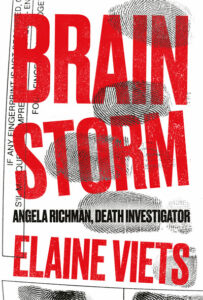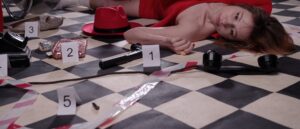
You know your prose will stun your editors with its brilliance. When you reread that passage, it brought tears to your eyes. The emotion quivers on the page.
So why are your editors asking you to cut and rewrite your favorite section? Why do they see your fiery passages as deep purple?
I don’t know about you, but I have the most problems when I’m starting a novel.
Once it gets going, I’m okay – sure, I have to watch for sagging middles.
But here is a problem I had with a rough beginning, when the murder came too late in Brain Storm.
The first book in my Angela Richman, Death Investigator series was hard to write:
I was starting a new series, and it was hard-boiled, not cozy, a change for me.
Also, the plot used my actual experience. In 2007, I had six strokes, brain surgery and a coma. It took seven years to get up the nerve to write about this, and another year for my agent to sell this story.
Here’s the plot: Death Investigator Angela Richman has a series of blinding headaches. She goes to the ER and Dr. Porter Gravois tells her she’s too young and fit to have a stroke. He sends her home, and she has six strokes and brain surgery. She’s saved by Dr. Travis Tritt, a brilliant surgeon with a lousy bedside manner. Dr. Tritt hates Porter Gravois, and when Porter is murdered, Tritt is the main suspect. Angela, still sick and drug-addled, has to save the man who saved her life.
When Brain Storm sold, my manuscript went to Bryon Quertermous, a freelance development editor.
Here’s what Bryon wrote:
Plot-wise, I think you have a good motive and solid characters and a nice arc. That said, I think the arc starts too late and needs to encompass more of the first half of the book as well. You do a good job of starting strong with the character and with Angela’s job and readers will forgive a little slow burn to get into this cool world, but we need to see some plot development sooner than almost halfway through as it is now.
The biggest note I have is that Dr. Porter’s death scene needs to come sooner in the book, ideally a quarter of the way in or so. For Angela to really work at her best as a character she needs to be actively investigating a death, not just playing armchair detective with her friend, the pathologist Katie, as she does now. I think there are some great interactions between the two of them and I don’t want those to go away, but I think you can kill two birds with this.
 First, you need to make a list of all of the scenes that come before Porter’s death. Next, write a little bit about each scene. Then figure out which ones can be reworked to come after that scene and which can’t, and then go from there.
First, you need to make a list of all of the scenes that come before Porter’s death. Next, write a little bit about each scene. Then figure out which ones can be reworked to come after that scene and which can’t, and then go from there.
I think a lot of the discussions with Katie about the Angel of Death can come after. I love the idea that you briefly toy with of having Angela obsessed with the perfect Hobie as the killer and, better yet, as a vigilante killer. I think Angela needs to come to this obsession sooner and it needs to coincide with her talks with Katie about the Angel of Death murders.
 You need to build her paranoia here and really play around with it as she wonders in her head if what she thinks about Hobie really is true. I think you need at least one more big set piece hallucination (like the fake hospital one which I though was brilliant) and I think as Katie realizes more and more that Angela isn’t playing devil’s advocate that she actually thinks Hobie is the Angel of Death and that he killed Porter this can create some nice tension between the two friends. Part of this will come from a line of investigation I think you need to develop where Angela starts digging into the backgrounds of the other Angel of Death victims to see if they have anything in common or if they were bad people who needed to die like Porter did.
You need to build her paranoia here and really play around with it as she wonders in her head if what she thinks about Hobie really is true. I think you need at least one more big set piece hallucination (like the fake hospital one which I though was brilliant) and I think as Katie realizes more and more that Angela isn’t playing devil’s advocate that she actually thinks Hobie is the Angel of Death and that he killed Porter this can create some nice tension between the two friends. Part of this will come from a line of investigation I think you need to develop where Angela starts digging into the backgrounds of the other Angel of Death victims to see if they have anything in common or if they were bad people who needed to die like Porter did.
Bryon gave me good advice: I don’t believe the murder should always be in chapter one – but if someone isn’t dead by the first third of the book the writer is making the fatal mistake of slowing the pace.
 But how could I cut those wonderful scenes?
But how could I cut those wonderful scenes?
Bryon had the answer: List all the scenes.
See which ones can be combined or relocated to another section of the book.
Kill the ones that slow it down. Be brave. If you want your book to live, you’re going to have to kill – or at least transform – those darling scenes.

Have you had to kill your darlings? Tell us about it.
 Here’s how Brain Storm turned out. https://tinyurl.com/7kwezp3t
Here’s how Brain Storm turned out. https://tinyurl.com/7kwezp3t

Elaine, a reverse outline (a few informal notes that summarize the chapter alongside the chapter number) as you write is an excellent way to get a quick glance at what happens when. I find myself wondering whether that one character kept the name Travis Tritt. (grin) Immediately brought to my mind the country-western star of the same name.
Re: Dr. Tritt: He is retired and living where corn don’t grow.
Good answer, Joe.
Yes, I kept the name, Harvey. He was a country boy who became a surgeon. He was often mocked for his name.
Good morning, Elaine. Thanks for sharing with us. I had no idea of what you went through fourteen years ago. Fair skies onward.
I like the idea of listing all the scenes in your book, as well as Harvey’s reverse outline. It provides a quick reference to who is doing what and to who (as the limerick goes) at any given moment.
Have a great day, Elaine.
It’s a good way out of a difficult problem, Joe.
I try to ease the pain of those cut scenes by reminding myself they’re there to help me get a better feel for the characters, setting, whatever, and what was in them is still there, just not on the page. And yes, I’ve cut brilliantly written scenes before. You can always put them in a ‘cutting room floor’ section of your website if you think they deserve being seen by others.
Great post, Elaine. Very helpful. The idea of listing the scenes with a description is helpful. Being able to move those scenes around (in the outlining stage) in an electronic file makes it easy. I had a similar problem with a story I’m working on where I realized I was introducing the antagonist too late, but I didn’t want the reader to know the antagonist’s identity until later. I moved a scene up, and showed him as a shadow and a dark figure in the middle of the night.
Thanks for a great post. Have a good day.
Thanks, Steve. Working with computers makes this idea easier. It would be impossible in the days of cut-and-paste.
Good idea, Terry. And having a “cutting room floor” section will give your readers an idea of how you write.
Oooh, like the outakes on a DVD, a bonus online. I like it!
Thanks for a glimpse into the process of making the books flow so well. You make it look easy, good to have a reminder that it’s not.
Oooh, like the outakes on a DVD, a bonus online. I like it!
Thanks for a glimpse into the process of making the books flow so well. You make it look easy, good to have a reminder that it’s not. (reposting to try to get my own info corrected)
Writing a novel is a group project, Mary. It takes editors and a little help from my friends, as the song says.
In the second book of my Grafton County Series I had a hilarious baby delivery flashback. I loved it, laughed every time I read it. My editor told me to cut it because it slowed the pace. She was right, of course, so I filed it away in my Unused Scenes doc. Then came the third book, and I tried to slip it back in. And…she made me cut it again, even though she thought it was hilarious, too. Can’t fault a girl for trying, right?
Some day you will find a home for that baby, Sue.
Hey, I meant to add how sorry I am to hear about your frightening medical issues. Six strokes is no joke. Hope you’re okay now.
I’m 99% recovered Sue, and very lucky.
I create a “killer scenes” file for my Scrivener projects. I’ll put ideas for scenes here, flesh them out a bit, and sometimes they end up in the book. I also have a file called “cut scenes” where I put the ones that, on second look, don’t fit. Some of them are really good darlings! So I move them over to the next project to see if they’ll fit.
Writers are like soup makers, Jim. We combine those scraps when we cook up our novels.
Elaine, I remember BRAINSTORM has great pacing so you nailed it. Thanks for including the editor’s suggestions. Really helpful to see *specifically* what he noticed and stumbled over. Gives good insight into how an objective third party views a story as opposed to how we see our own work.
I’ve kept outtakes files and have been sure some scenes would eventually be put back in. Yet, on final review, they were not needed at all.
I’ve done that, too, Debbie. After the book is finished, I look at my outtake files and wonder why I saved them.
Elaine, Thanks for sharing your personal story and how played into your novel. So glad that you’re well and wishing you good health and lots of novels in your future.
My editor red-lined a paragraph in one of my books that I thought was perfectly brilliant I showed it to my husband, expecting his conjugal support. When he mumbled something unintelligible about over-the-top, I decided maybe I should let it go. It still hurts.
I use Scrivener and I find the outline view is particularly helpful. For each scene, I have a few notes that indicate the goal of the scene, a very short synopsis, and how I hope it will impact the reader. I print the outline view and go through it to see if things are lining up in a way that will keep the reader engaged. Another thing I like about Scrivener is the ease of moving chapters and scenes around. I use that a lot. 🙂
I really need to give Scrivener another chance–I’ve had it for ages, but have never written a novel with it–only used it to create a reference document for a series. All the bells and whistles seem almost overwhelming, but your comments encourage me to look at it again 🙂
I’m with you, Dale.
Dale and Elaine, see my post on the subject.
Thanks, Jim.
I’ve never used Scrivener, but so many good writers recommend it. It may be time for me to look at it.
I’m not very sentimental, so I have no problem killing my darlings. If it doesn’t work, it goes, and the relevant bits get worked in somewhere else. The closest I’ve come to having a darling is in my previous WIP, the MC is making Christmas cookies with his friend while debriefing. I haven’t gotten into the edits for that one, so it might go.
For outlines, I like doing a “disappearing outline.” Which means, I erase the chapter notes when said chapter gets written. It gives me a sense of accomplishment, but it also forces me to reread and reevaluate my manuscript if I want to get a big picture of what I’ve written.
Now that’s a new way to get through an outline, and the constant re-evaluation is a good idea. Thanks for the tip.
I’ve had the opposite problem, beginning too early, and had to cut the opening of an early novel and start later in the narrative, when the plot really begins. I took a workshop once where the teacher compared the story of a murder to the plot of the investigation. In his view, mystery novels usually open in the beginnings of the investigation–not necessarily when a body is found, but when a mystery arises. Whereas the story of the murder/crime begins much earlier, of course.
My wonderful developmental editor Mary Rosenblum (who sadly passed away in 2018) deftly identified the problem with the outline for my third Empowered novel, “Empowered: Outlaw,” namely that I was beginning too early, and not in a dramatic moment. My hero and her best friend were looking for my hero’s missing sister. I’d originally opened the book with a scene of Mat and Keisha, now off the grid, surviving. The new opening had them finding a crucial clue to send them after the sister.
Thanks for sharing your story of how you had to kill your plot darlings and rejigger your novel! Have a fine day!
Starting the story too early is a problem many of us face, Dale.
This quote from you teacher — “In his view, mystery novels usually open in the beginnings of the investigation–not necessarily when a body is found, but when a mystery arises. Whereas the story of the murder/crime begins much earlier, of course” — is priceless.
If I got nicked for every darling I’ve killed, I’d be doing life in writer prison. Great to hear you recovered from a very serious situation, Elaine. Enjoy your day and keep on writing!
I’m getting more ruthless as I keep writing, Garry.
The afterward in Brain Storm contains more of the real life story of “being too young for a stroke.” I remember those days and the stop on a book signing tour with your “quarter million dollar haircut” after surgery. And no bagpipes.
You do have a good memory, Alan. The brain surgery shaved only half my head — not the best look. The ER doc advised my husband to start planning my funeral, and Don forgot the bagpipes. Always wanted “Amazing Grace.”
You’re lucky to have such a good editor. So many authors don’t.
For better or worse, I’ve had very few editors who wanted me to rebuild or cut sections of my books. One told me to cut length with a few vague suggestions that told me she wanted to turn my ROMANCING THE STONE into a generic INDIANA JONES action/adventure. A really weird choice since it was a romance line. I’m glad that publisher went belly up before a much worse book went to press.
Sounds like you have the good sense not to follow this bad editor, Marilynn.
I followed it because it would have been my first sale. I just didn’t like it.